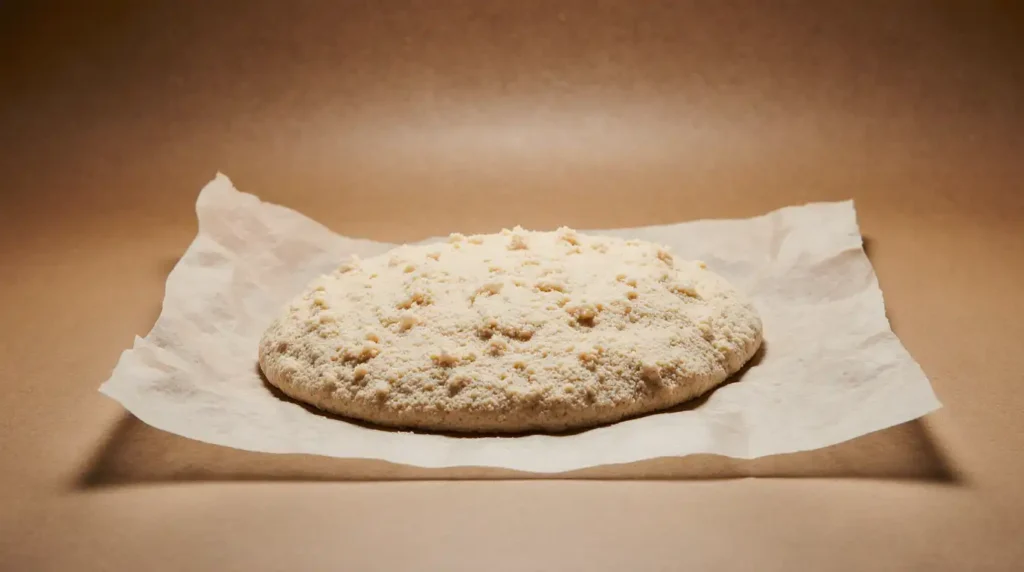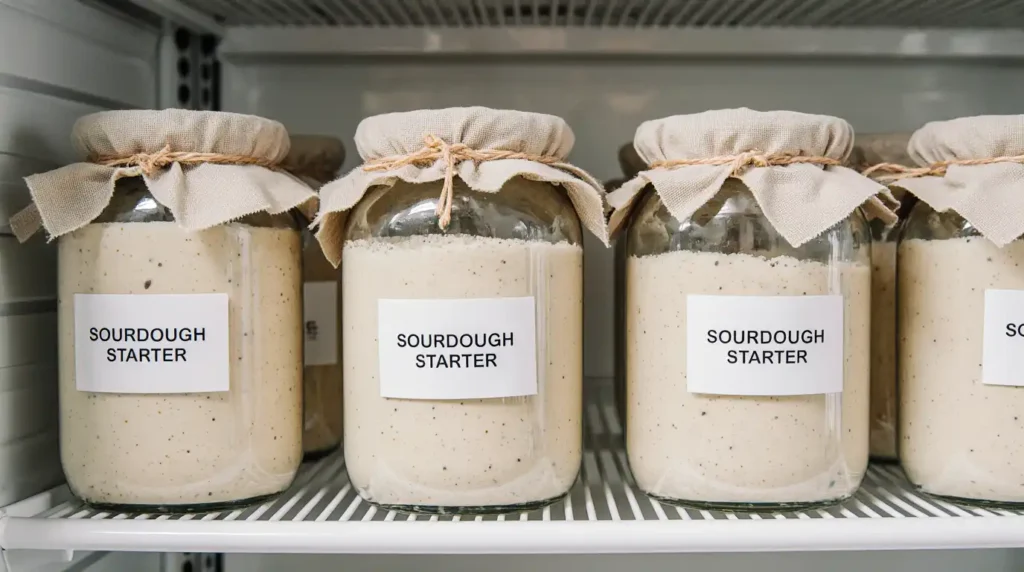Here’s the deal: sourdough starter seems intimidating at first, but it’s really just flour and water that you keep alive. That’s it.
Sure, you’ll read all kinds of rules online—exact feeding times, mystical ratios, dire warnings about hooch. But most of it? Not necessary. Starters are tough. They want to live.
This guide is for people who just want straight answers on how to store, feed, and maintain a sourdough starter without losing their minds or wasting flour.
We’ll talk:
- How to feed it (no fancy schedules).
- How to store it (fridge, freezer, even drying it).
- What’s normal (and what’s not).
- How to rescue it if you forget it for too long.
If you’re sick of throwing out starter because you don’t know what to do with it, or you’re tired of second-guessing yourself every time you see a weird liquid on top—this is for you.
Feeding Schedule
Honestly? Feeding your sourdough starter is a lot simpler than people make it sound.
It really comes down to where you’re keeping it and how often you want to bake.
If You Keep It on the Counter
- Feed it once or twice a day.
- Hot kitchen? It’ll eat faster. Twice daily might help.
- Cooler room? Once a day is usually enough.
- Just watch it—if it looks runny or smells extra sour, it’s hungry.
If You Store It in the Fridge
- Feed it about once a week.
- That’s all you need.
- When you want to bake, pull it out and give it 1–2 room-temp feedings to get it bubbly again.
How Much to Feed
- A typical ratio is equal weights starter, flour, and water.
- Example: 50 g starter + 50 g water + 50 g flour.
- No scale? Just eyeball equal volumes. It doesn’t have to be perfect.
Quick Tips
- Always discard about half before feeding so it doesn’t take over your kitchen.
- Missed a feeding? Don’t freak out. Just feed it again.
Starters are hard to kill. Think of it like a houseplant that droops when it’s thirsty—it’ll perk back up once you feed it.

How to Store Your Starter
Here’s the truth: you don’t need to babysit your starter every single day. Storage is your best friend if you don’t want it to take over your life.
Fridge Storage (Easy Mode)
- Feed it like you normally would.
- Let it hang out on the counter for an hour or two so it wakes up a bit.
- Then cover it loosely (not airtight) and pop it in the fridge.
That’s it. Done.
How often do you have to feed it?
- Once a week is fine.
- Even if you forget for two weeks? It’ll forgive you. Just scrape off any liquid (or stir it back in) and feed it.
Freezer Storage (Long Breaks)
- Want a real break? Freeze it.
- Feed it first.
- Scoop some into a freezer-safe bag or container.
- Label it so you don’t forget what the weird lump is later.
To use it again:
- Thaw overnight in the fridge.
- Feed it a couple of times at room temperature.
Drying Your Starter (Ultimate Backup)
- Spread it thin on parchment paper.
- Let it dry out completely.
- Break it into flakes.
- Store it in an airtight jar.
To revive:
- Mix with warm water.
- Feed daily until it’s lively again.
A Few Quick Tips
- Always use clean jars.
- Loose lids in the fridge so it doesn’t build up pressure.
- Don’t freak out if it smells strong or boozy after storage—it just needs food.
Honestly? Your starter doesn’t mind naps in the fridge or even long hibernation in the freezer. It’s meant to make your life easier, not harder.

Avoiding Hooch and Mold
Let’s be real: everyone who keeps a starter eventually opens the jar and thinks “What is that weird liquid?” or “Is this fuzz supposed to be here?”
Good news: most of the time it’s normal—or fixable.
What’s Hooch?
- That grayish or brownish liquid on top? Totally normal.
- It’s just alcohol your starter produces when it’s hungry.
- How to handle it:
- Stir it back in for more tang.
- Or pour it off if you want a milder flavor.
Basically, hooch is your starter saying, “Feed me, please.”
How to Avoid Too Much Hooch
- Feed on schedule (daily on the counter, weekly in the fridge).
- Use a clean jar with enough room for rising.
- Don’t let it sit neglected for weeks on the counter.
Even if you forget, it’s usually easy to rescue.
Mold: When to Actually Worry
Here’s the bad news: mold is the one thing you don’t want.
- Bad signs:
- Pink, orange, green, black fuzzy spots.
- Weird streaks that weren’t there before.
- Smells truly rotten (not just sour or alcoholic).
If you see mold? Sorry—it’s time to toss it and start fresh. Don’t risk it.
Preventing Mold
- Always use clean containers.
- Don’t use dirty spoons or hands to stir.
- Keep lids loosely covered to let it breathe but keep out debris.
- Store it in the fridge if you’re not feeding daily.
Real Talk
You’ll see weird stuff as you learn. Most of it’s normal. Don’t panic every time the liquid separates or it smells strong. Just feed it.
Your starter wants to live.
Reviving a Weak Starter
So you opened your jar and it smells like nail polish remover. Or it’s barely bubbling. Or maybe you forgot about it in the fridge for… too long.
Good news? It’s probably not dead. Just hungry and a little sad.
Here’s how to bring it back to life:
1. Check for Mold First
- Mold = toss it. Sorry.
- Weird colors (pink, orange, green fuzz) or rotten meat smell = no saving it.
If it’s just gray liquid (hooch) or smells strong/alcoholic? Totally fine.
2. Remove Hooch and Crusty Bits
- Pour off the hooch on top.
- Scrape away any dry or crusty edges.
You want the healthiest-looking part of the starter underneath.
3. Keep Even a Small Amount
- Even a tablespoon is enough to revive.
- Scoop the best part into a clean jar.
4. Feed Generously
- Use a 1:2:2 ratio (starter : water : flour) for a boost.
- Example: 25 g starter, 50 g water, 50 g flour.
- Stir well so there are no dry spots.
Higher feed ratio helps dilute waste products and gives it plenty of food.
5. Keep It Warm
- Room temp is best (70–78°F if you can).
- Warmth speeds up activity.
6. Repeat Daily
- Feed once or twice daily.
- Discard half before each feed.
Usually you’ll see bubbles and rising within a few days.
How Long Does It Take?
- Mildly neglected? 1–2 days.
- Really weak or forgotten in the fridge for months? 3–5 days or more.
Be patient. It’s alive—it just needs time and food.
Pro Tips
- Use whole wheat or rye flour for a feeding or two. Extra nutrients = faster revival.
- Keep the jar clean. Mold loves dirty rims.
- Don’t give up too soon. Starters are stubbornly resilient.
If you’ve ever killed houseplants, don’t worry—starters are way harder to kill. A little attention goes a long way.
Conclusion
Look, keeping a sourdough starter alive isn’t some fancy, high-pressure art. It’s honestly just flour, water, and a little attention.
You don’t need perfect ratios or rigid schedules. No need to stress over daily feedings, either. Instead, just understand the basics:
Feed it when it’s hungry.
Store it in the fridge if you need a break.
Freeze or dry it if you want a longer one.
Yes, mold is the only real dealbreaker. But hooch? Totally normal. If you forget your starter for a bit—don’t panic. Most can bounce back with a few feedings.
The truth is, sourdough is forgiving. It wants to stay alive.
So take a deep breath. Feed it when you can. Store it when you need to. Revive it if you slip up.
Most importantly, bake something you actually want to eat. Because at the end of the day, this isn’t about being perfect. It’s about making good food, cutting down on waste, and having a little fun in the kitchen.
Got questions? Drop them in the comments. Or share your best sourdough save story. Let’s figure it out together.
Simple Sourdough Discard Recipes – for “easy ways to use leftover starter”
Sourdough Pizza and Flatbreads – “recipes to use an active starter”
Sourdough Breakfast Ideas That Aren’t Bread – “alternative ways to use discard”
Savory Sourdough Snacks and Appetizers – “great for entertaining or snacking”
King Arthur Baking: Sourdough Guide – for technique help
FDA Food Safety Tips – for storage safety and handling
The Perfect Loaf – for advanced sourdough tutorials
Ready to bake? Don’t let that starter go to waste. Feed it, store it, and turn it into something delicious. Got questions or your own tips? Drop them in the comments so we can all learn together!

